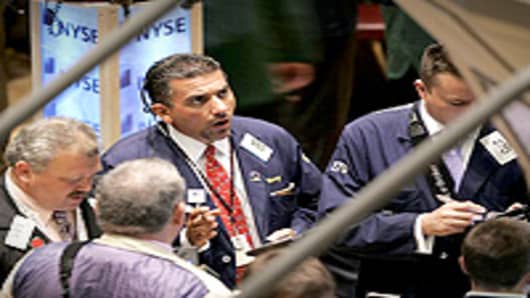The focus on fundamentals is about to begin.
For the last three months, investors have been ignoring the weak economic backdrop and plowing money into stocks because of the cheap money swirling from central banks around the world. Investors are searching for yield in an environment of rock bottom rates.
But judgment day is coming.
The fourth quarter has begun and the third-quarter earnings will start to flow, giving us a window on just how anemic the last three months have been in the real economy. (Read More: Stocks End Lower, but Log Best Third Quarter Since 2010.)
That doesn’t mean the chasing of the highly volatile big performers will let up. But it does mean selectivity when buying stocks will be more important than ever. And the risks of a big sell-off are higher.
Big institutions and other deep pools of capital, such as pension funds, have been playing catch up, chasing stocks even in the face of anemic economic growth, stubbornly high unemployment, and a mess in Europe that has yet to be resolved. (Read More: Fed to Ease Until Jobless Rate Falls Below 7%: Fed’s Evans.)
The Dow Jones Industrial Average is up more than 10 percentyear to date, 4.3 percent in the third quarter. The S&P 500 index is more than 15 percentyear to date, and 5.8 percent in the past quarter, and the Nasdaq Composite Index , the big winner of all is up nearly 20 percentyear to date and 6.2 percent in the third quarter.
But as money has flowed into stocks, the backdrop for corporate earnings has worsened. Gross domestic product, the broadest measure of the economy, was revised downward to show a slow 1.3 percent growth versus an earlier estimate of 1.7 percent.
Earnings for the third quarter are seen contracting — S&P Capital IQ is expecting a negative showing for third-quarter numbers, with profits down 1.9 percent. It would be the weakest earnings picture since the second quarter of 2009, smack dab in the middle of the recession.
Revenue is seen growing just 1.4 percent. To put that in context, historically over the last 10 years, revenue has grown some 7 percent.
The drags in the third quarter will once again be materials and energy, where earnings are expected to fall about 19 percent apiece.
There are some positives, including the financials, which of course has been where the momentum has been in stocks. Earnings for the banks are expected to rise 8 percent, with the commercial banks and insurance companies seeing gains of some 25 percent, which is coming off of a low base. (Read More: Is Third Quarter the Bottom for Slowing Earnings?)
Rich Peterson from S&P Capital Markets said the reason the financials are expected to see a boost is that the third quarter has been busy for leveraged buyout deals — the best since the third quarter of 2007, when more than $45 billion dollars in deals took place.
The fourth quarter will be boosted by more catch up: There’s about $100 billion in so-called dry powder — unused capital from earlier fundraising — whereby private-equity firms may be rushing to get deals done before year end.
Once again, future guidance from these companies will be critical and we will get more clarity once we know who will occupy the White House.
But the guidance in the past few months has not been a positive. Of the 101 companies that provided guidance for the third quarter, some 72 percent were negative. (Read More: Obama-Romney Debate Faces Off-Script Challenge.)
Things are seen picking back up in the fourth quarter, with overall earnings growth expected at nearly 10 percent — but many sources I speak to are questioning such a bounce from negative to double-digit growth.
Revenue is still expected to be anemic in the fourth quarter, coming in at about 3 percent, with materials seen rebounding 25 percent based on increased demand for construction, metals, and mining.
By all counts, these numbers are underwhelming. Particularly in a market that does not have a whole lot of room for error with the Fed bond-buying program taking stocks high and expectations even higher.
—By CNBC’s Maria Bartiromo; Follow Her on Twitter @MariaBartiromo


